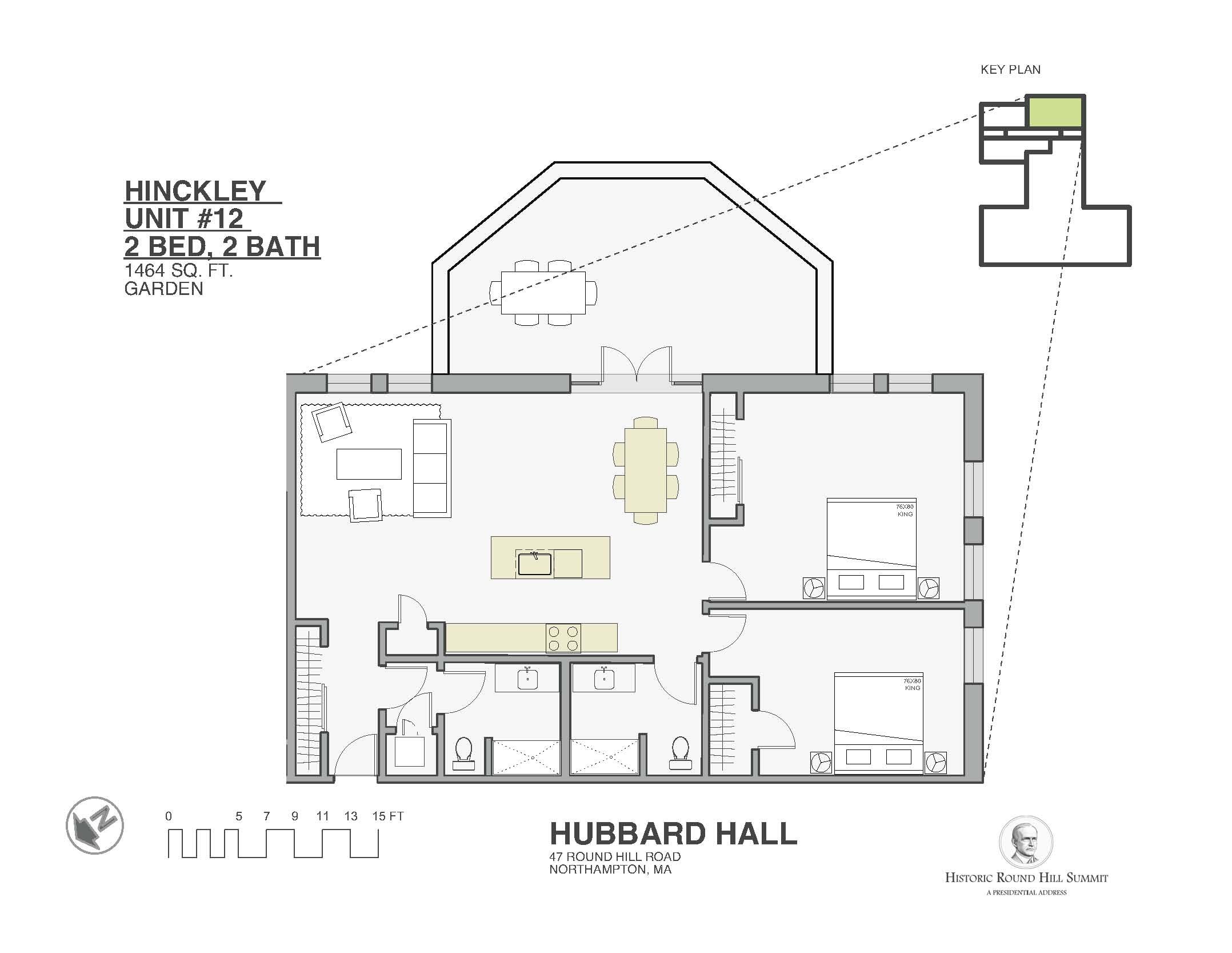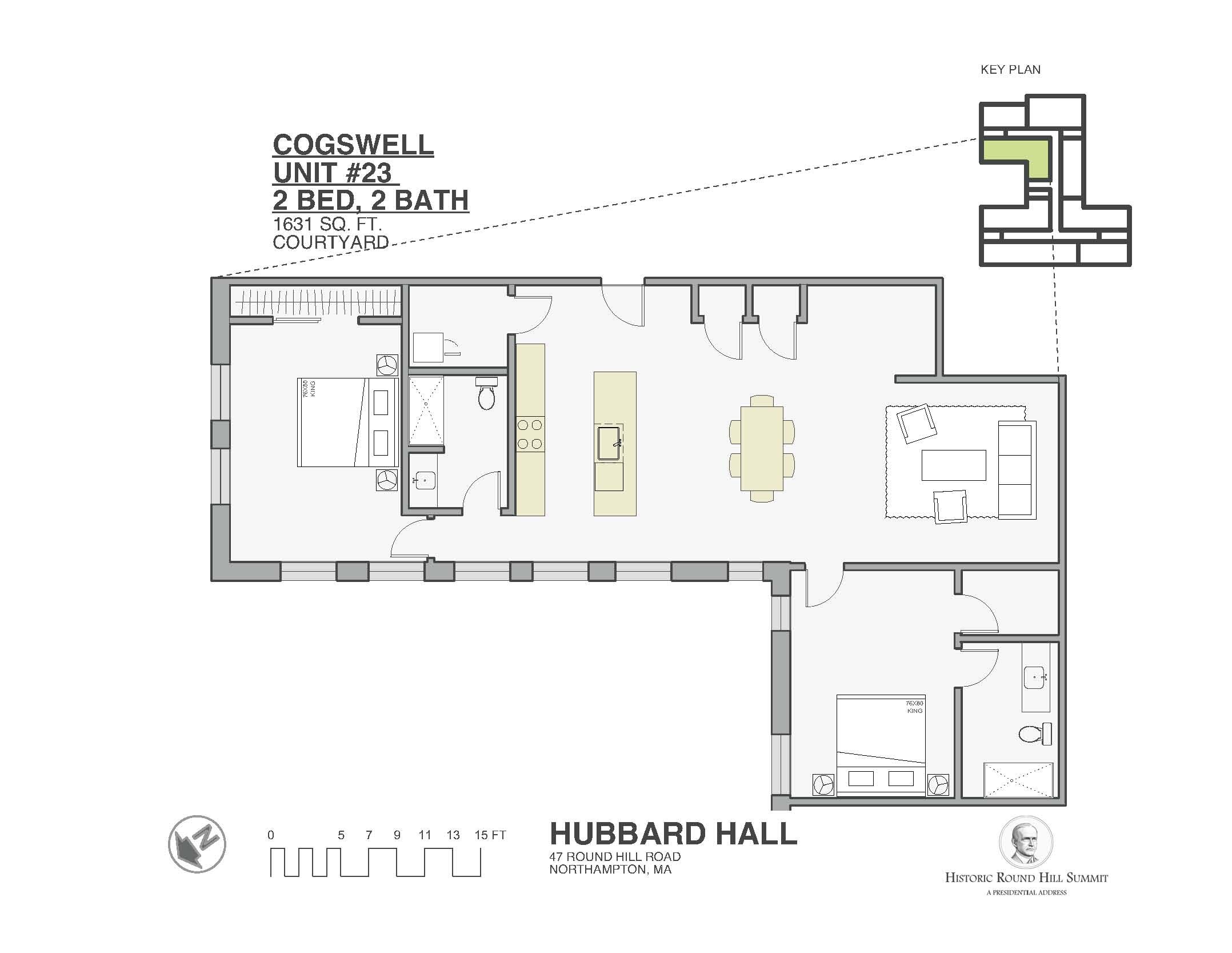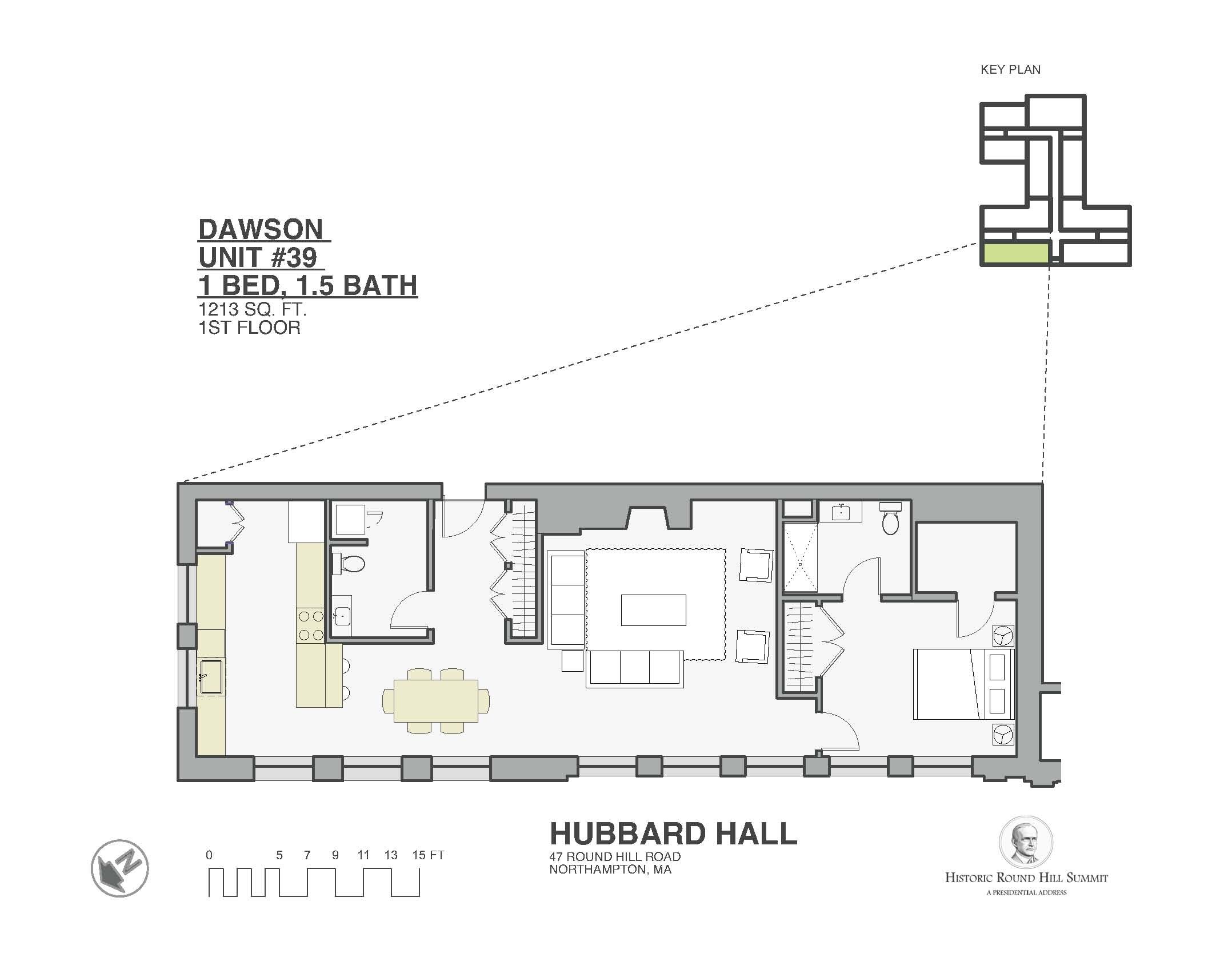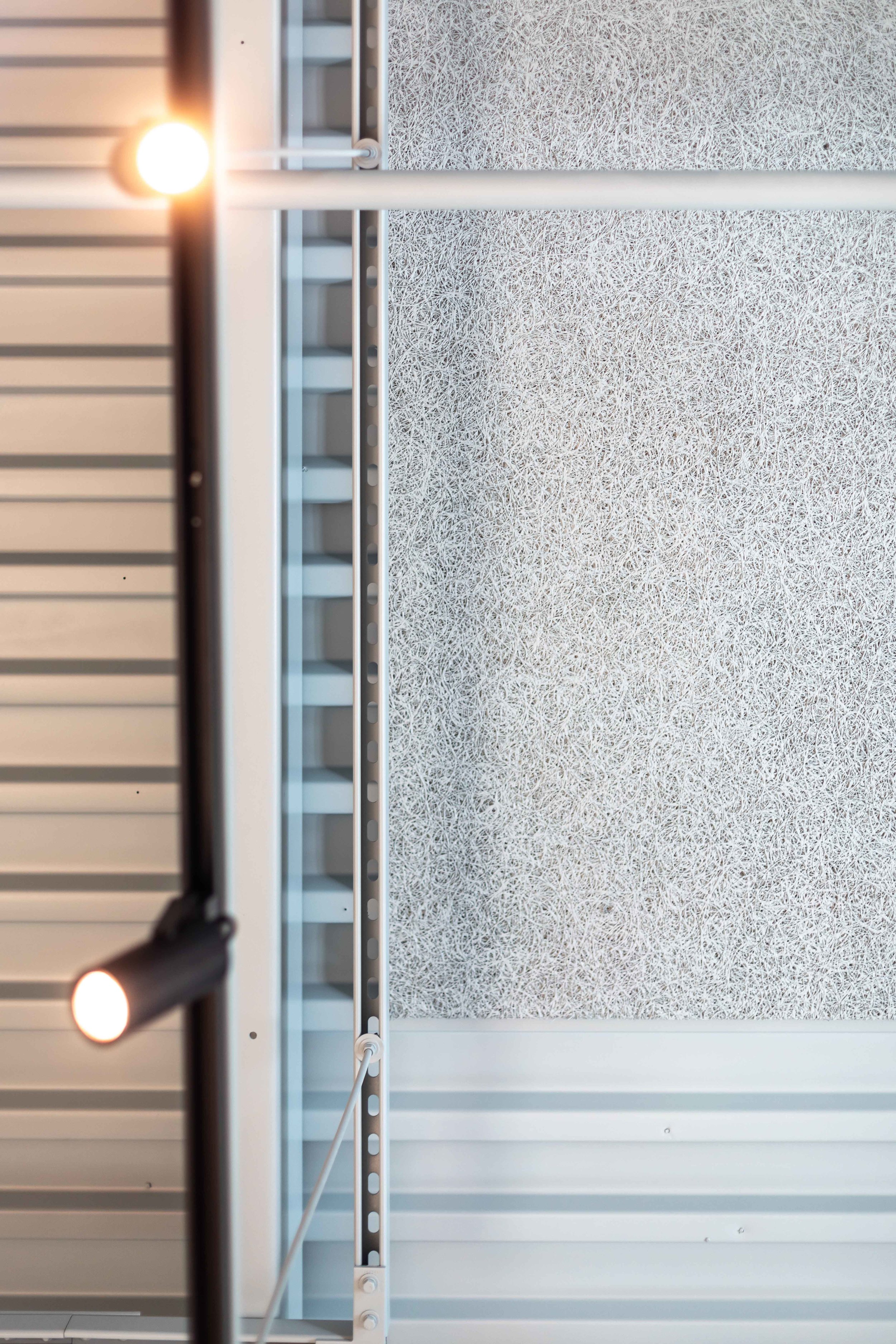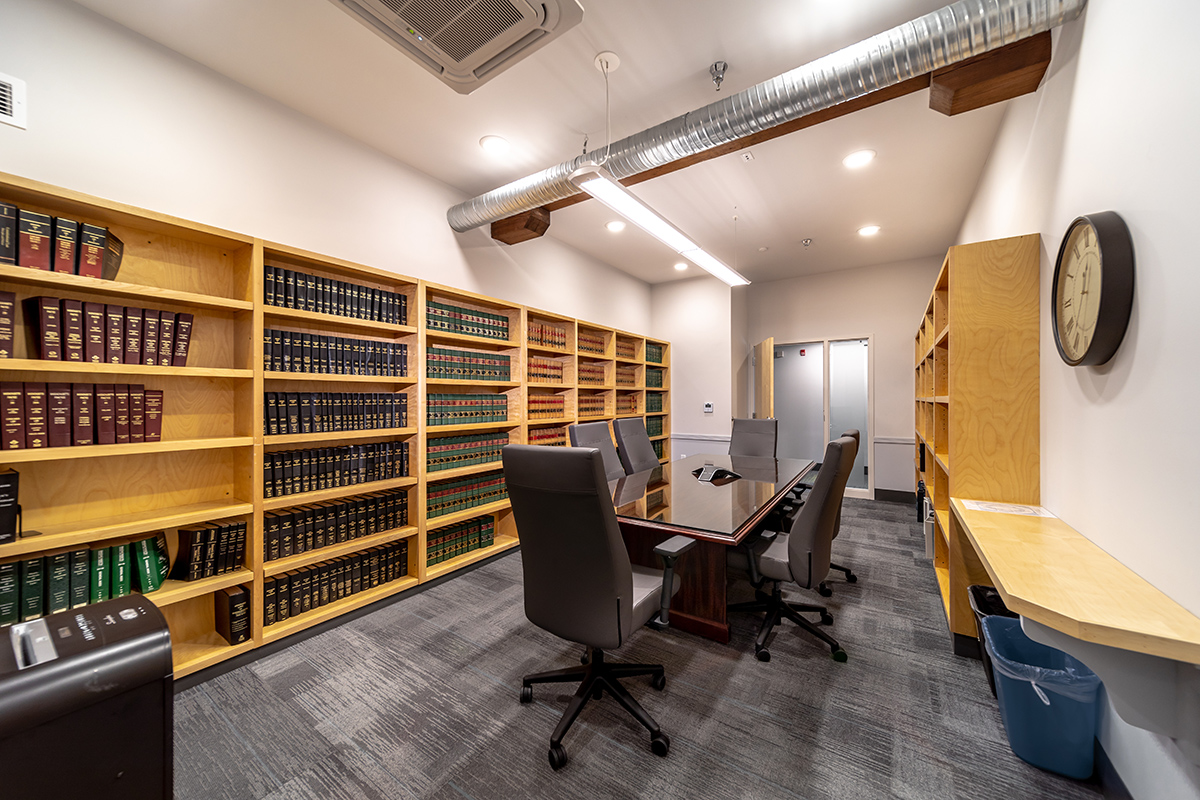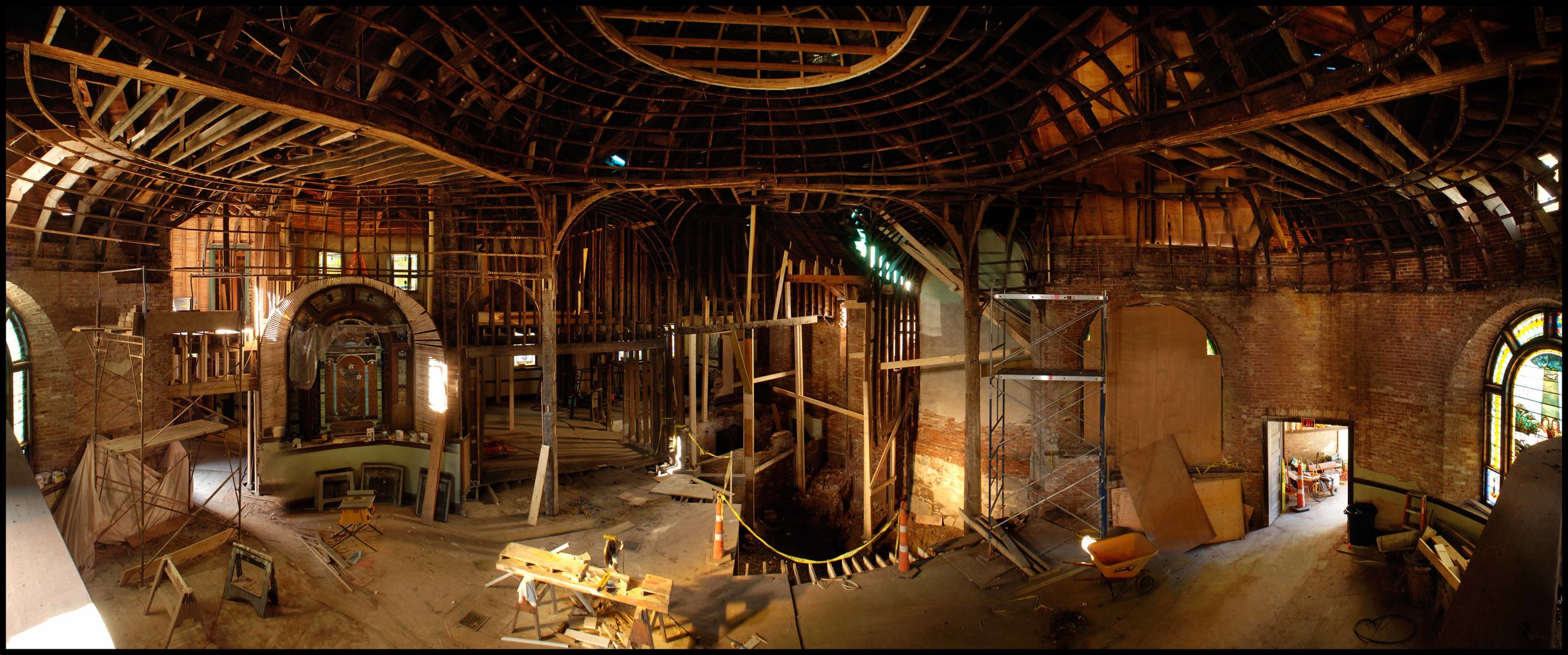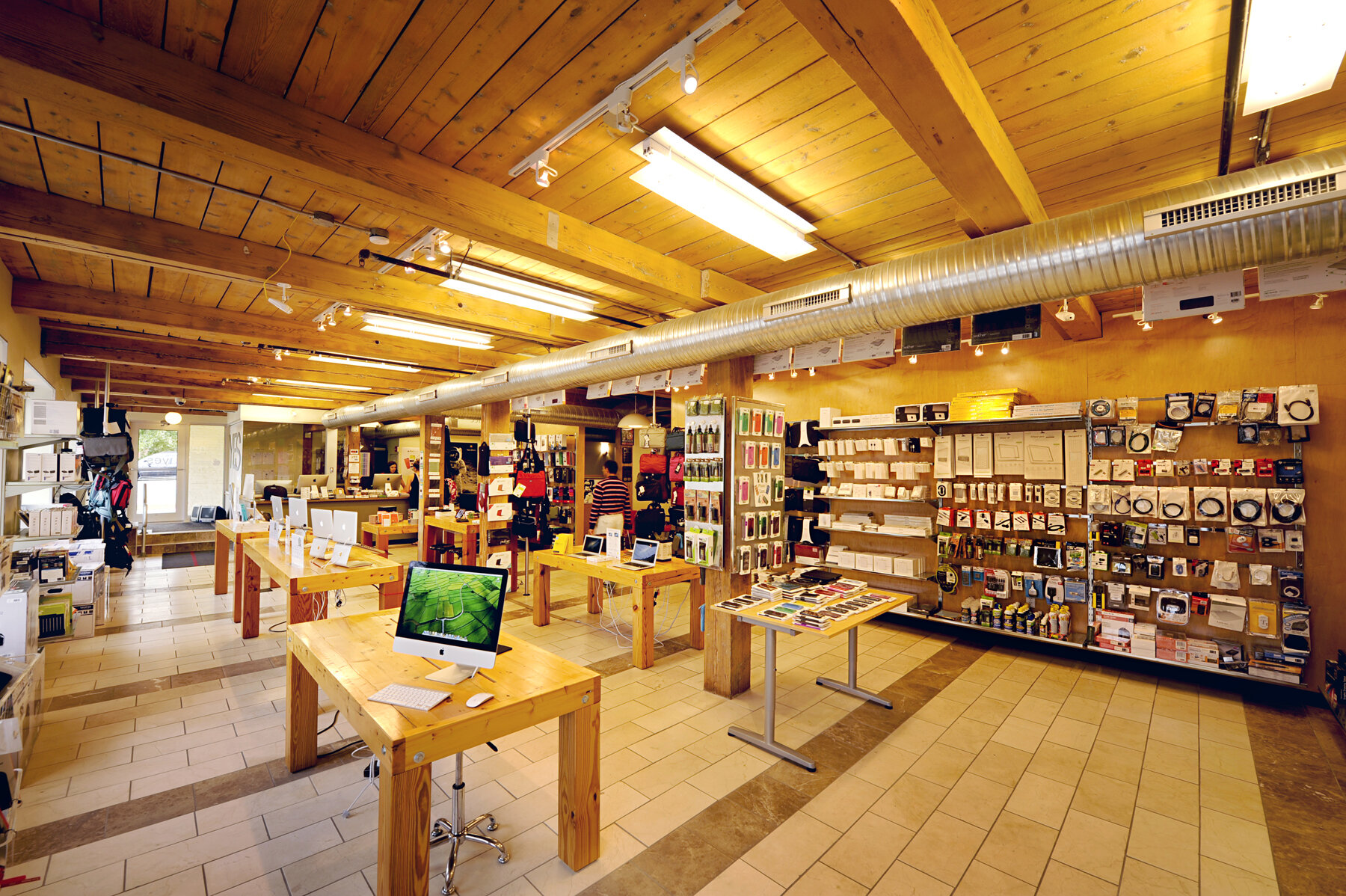Just Big Enough Competition
Boiler House
The former Boiler House for the historic Clarke School for the Deaf, this solidly-built masonry building had fallen out of use many years prior to renovation. It was carefully cleaned and a 2nd interior floor was added. Large ground floor and arched second floor window openings were preserved with new efficient windows in their place. This project exemplifies how a bright, open modern interior spaces can fit within the historic context of the traditional New England school buildings and campus.
The tall interior space, once home to steam boilers that heated the entire campus, now hosts a second floor with wood stairs and a custom designed metal handrail to the buildings upper two units. Light fills the new apartments through the new operable energy efficient windows.
Building on our expertise rehabilitating historic buildings with modern efficient building envelopes, TDA negotiated local, state & national historic reviews to help this renovation earn Historic Preservation Tax Credits. The completed building is one of a half dozen other buildings from the campus that TDA has helped to renovate for residential and office uses.
Gawith Hall
Set atop a hill overlooking downtown Northampton, Gawith Hall is the largest of the buildings that make up the historic Clarke School for the Deaf. The school sold most of its campus and a private company hired TDA to convert this 19th century former classroom-building-turned-dorm into a modern office building.
The three-story masonry building had first to be stabilized and reinforced to meet current code. The steel frame inserted into the building became a central design feature in the new entry addition, establishing an industrial theme that continues through the existing building. Historic details, clean lines and warm wood finishes combine with exposed blackened steel and polished concrete in the open and visually engaging workspace. The high ceilings, glass partitions and communal spaces were designed with the company’s goal in mind of attracting and maintaining talented staff in an era of high competition for skilled workers.
TDA negotiated local, state & national reviews to help this renovation project earn Historic Preservation Tax Credits. The completed building is one of a half dozen other buildings from the campus that TDA is has helped renovate for residential and office uses.
Pond Building
The Pond Building on Bank Row in downtown Greenfield dates from 1890. TDA was engaged to completely renovate the building after having been left derelict for many years, including significant structural deficiencies uncovered during the design process. This project was supported by Federal and State Historic and New Market Tax Credits.
The Pond Building houses Magpie Restaurant and residential apartments. These projects were recipients of 2012 awards from the Massachusetts Historic Commission and Preservation Massachusetts. Both awards were: “to recognize and celebrate the efforts and accomplishments of those individuals and organizations that have made significant contributions to preserving the Commonwealth’s historic resources.”
Hubbard Hall
A 1920s administrative and classroom building at the historic Clarke School for the Deaf, Hubbard Hall’s high ceilings and generous windows have been repurposed as high-end residences. Perched atop Round Hill overlooking downtown Northampton, these luxury apartments boast original historic details, restored and new hardwood floors, fireplaces and upmarket modern amenities.
The historic masonry building received new insulation at all exterior walls and new double pane windows. Finish materials and HVAC equipment were selected carefully for efficiency and reliable performance.
Sustainable features
Energy Efficiency:
Very high insulation values in walls, roof and foundation
Double pane energy efficient windows
Airsealing details
Energy recovery ventilation
Digital controls in each room control the heating system.
Window are used to get natural daylight into as much of the building as possible
Materials:
All paints & finishes used are low- or no-VOC (volatile organic compounds).
Locally sourced wood and stone
Northampton Arts Trust
The Arts Trust building, known as 33 Hawley Street, is a vibrant arts facility in Downtown Northampton, MA, that includes classrooms, rehearsal space, gallery & two large performance spaces. After working with the Arts Trust for a number of years to find a suitable site for a new facility for five local community arts organizations to share one roof. The primary goal of the project was to bring these five groups together in a cohesive building layout. A large communal, three story lobby connects the seven main rooms providing a cohesive central collecting space for before and after events or classes.
The building envelope is made of highly efficient insulated metal panels that provide superior protection for air and thermal infiltration. Whenever possible the building systems run on electrical powered from the large (equivalent to 75 residential systems) photovoltaic system on the roof, the larges of its kind in Northampton. The interior is a bright industrial space with natural day lighting throughout and locally sourced lumber and timber, warming the feel of the former warehouse.
33 Hawley Street has become the vibrant arts space that the community wanted, fulfilling the ethos of “keeping art in the heart” of downtown Northampton with both indoor and outdoor spaces for performance, expression and creative endeavors or all types.
Sustainable features:
Energy Efficiency:
Very high insulation values in walls, roof and foundation
Air tight detailing used to prevent energy loss
Heating and air conditioning use energy recovery
Smart controls in each room control the heating & cooling system
Day lighting strategies are used to get natural lighting into the deep interior spaces.
176 kW photovoltaic array on the roof to power much of the buildings energy needs.
Materials:
Locally sourced wood
Interior finishes were chosen for their natural durability, beauty and environmental integrity, locally sourced whenever possible.
Allen Block
The Allen Block building on the corner of Main and Bank Row dates from 1827. TDA was engaged to completely renovate the building after having been left derelict for many years, including significant structural deficiencies uncovered during the design process. This project was supported by Federal and State Historic and New Market Tax Credits.
The Allen building at the center of downtown Greenfield now houses Greenfield Coffee, lawyer’s offices and loft style residential apartments. These projects were recipients of 2012 awards from the Massachusetts Historic Commission and Preservation Massachusetts. Both awards were “to recognize and celebrate the efforts and accomplishments of those individuals and organizations that have made significant contributions to preserving the Commonwealth’s historic resources.”
Abercrombie Building
An unused former liquor warehouse building that backed up on the tracks just down the hill from Main Street, the Abercrombie Building’s front on Bank Row defined the industrial edge of town. Over time, the spreading downtown came to encompass the property and TDA was hired to help convert the building into offices.
The owner was pursuing National Trust Historic Preservation Tax Credits for the building. Accordingly, TDA focused on highlighting the existing wood structural timbers and brick in the interiors.
The tenant, the District Attorney, had very specific requirements, which TDA addressed through an iterative process of research, design and review, finalizing layout plans that kept working groups together and preserved necessary adjacencies.
Sound separating walls and ceilings were inserted into the building in the most discreet manner possible to preserve the feel of the original structure. As a warehouse, the building had fewer windows than would be needed for professional offices, so TDA continued existing window patterns and styles, adding windows that increased the natural daylighting in the building and provided views to its occupants.
Baptist Church Performing Arts
Northampton’s 1903 First Baptist Church is a current project under construction. The 15,000 square foot former church is being converted to a modern performing arts and banquet facility. Extensive structural and mechanical renovations were necessary to modernize the building and prevent further collapse of the structure.
There will be a theater space, meeting rooms, three full bars, a banquet facility and a full commercial restaurant kitchen. The building will be fully accessible with a new elevator. All interior surfaces are removed and a new decorative plaster and wood interior will be built. The central theater space has a large 3-tier dome that is being rebuilt and restored. There will also be a large outdoor terrace accessible from the interior. All aspects of the project are designed by Thomas Douglas Architects.
196 Pleasant Street
Located at the entry to Northampton’s vibrant downtown is a 1870’s brick, 12,000 square foot, 4 story, former industrial building. It was constructed for the production of specialty woven fabrics like tapes, ribbons, belts and webbings. It was purchased and renovated by Thomas Douglas Architects and Yes Computers.
Douglas Architects designed the architecture, signage, lighting and all interior spaces, including the Yes Computers retail space and three upper floor office spaces. The original timber framing and floor decks were exposed and sandblasted. The interior walls are furred-out and insulated with spray foam insulation and the brick facade is painted with long lasting and environmentally green Kiem silicate natural mineral paints. Original 3” thick factory floor decking was used to construct retail tables in Yes, further reinforcing the green and sustainable image of Yes.
The facade is lit with Color Kinetics color changing LED floodlights. Douglas Architects designed the Yes building sign which is aluminum channel letters with a double row of neon tube lights. This building welcomes visitors to the expanding downtown “shop row” of Northampton.
Northampton Fire Station Restoration
This former fire station has been a focal point for Northampton since its construction in 1872. When the city decided to build a new station and sell this “surplus structure”, the non-profit Media Education Foundation purchased it and the old building was given new life. Its new incarnation epitomized the revitalized image and feel of the downtown Northampton.
Towers became unique office spaces and garage bays became restaurant seating. The old firehouse overhead doors became the entrance to a new café on the ground floor and the floor above was turned into community, cultural and office space for the Media Education Foundation. New second floor offices were opened up to the soaring space above the old ceilings. First floor components show off the former industrial materials of the fire station structure.
The patio outside and the community spaces inside are always busy and lend new life to the downtown streetscape. The 11,000 square foot space is now more central and trafficked than ever before.
Easthampton Fire Station
Silas Kopf has been making studio furniture and fine European marquetry since 1973. He purchased this former fire station from the town of Easthampton and, with the help of Thomas Douglas Architects, he transformed an 8,000 square feet fire station from its original layout to a modern structure housing his studio shop and living spaces. This and other historic structures are integral to the old town’s identity, and this restoration enlivens the street scene without compromise.
The first floor, which used to be the fire station garage, now houses a high-end woodworking shop, an office, and a retail store. The second floor has two apartments, and the old fire tower holds a roof deck. We replaced the original fire station doors with arched windows and installed all new heating and electrical systems, including a radiant heat floor.
Conway Street School
TDA worked with the owner/developer to transform an abandoned early 1900’s elementary school building into twelve apartments with very high energy efficiency. This project transformed a derelict building into one of the more iconic and desirable properties in town.
The structure of the three story, 4500 square foot masonry building was in excellent shape, allowing the team to completely gut the interior and begin the redesign with ample freedom also while maintaining the historic character of the building’s exterior.
The reimagined design takes advantage of the tall windows and high ceilings to create spaces that are airy, light and dramatic. The second floor units each have an upper floor while the even the basement units have plenty of light and space. The entire project has an emphasis on energy conservation and efficiency features.
Sustainable features
Energy Efficiency:
Very high insulation values in walls, roof and foundation
Triple pane energy efficient windows
Airsealing details
Energy recovery ventilation
Digital controls in each room control the heating system.
Window shading from solar hot water system
Window and skylights are used to get natural daylight into as much of the building as possible
Materials:
All paints & finishes used are low or no VOC (volatile organic compounds).
Locally sourced wood and stone
Interior finishes were chosen for their natural durability, beauty and environmental integrity
30 Olive
TDA worked with the owner to transform this 1920s former mill building, located just down from the center of the city, into a modern apartment building while preserving signature interior details and historic exterior features.
The energy efficiency of the building envelope was improved immeasurably through careful airsealing and insulating, new windows, a new well-insulated roof and solar panels for both hot water and electricity generation.
Sustainable features:
Energy Efficiency:
Very high insulation values in walls, roof and foundation
Air tight detailing used to prevent energy loss
Heating and air conditioning use energy recovery
Day lighting strategies are used to get natural lighting into the deep interior spaces.
Photovoltaic and solar hot water arrays
Materials:
Interior finishes were chosen for their natural durability, beauty and environmental integrity, locally sourced whenever possible.





















